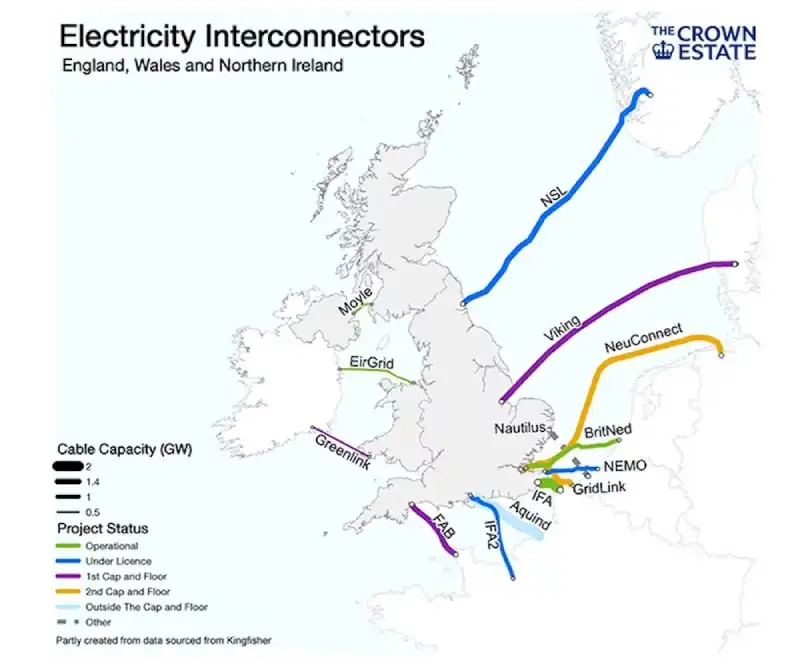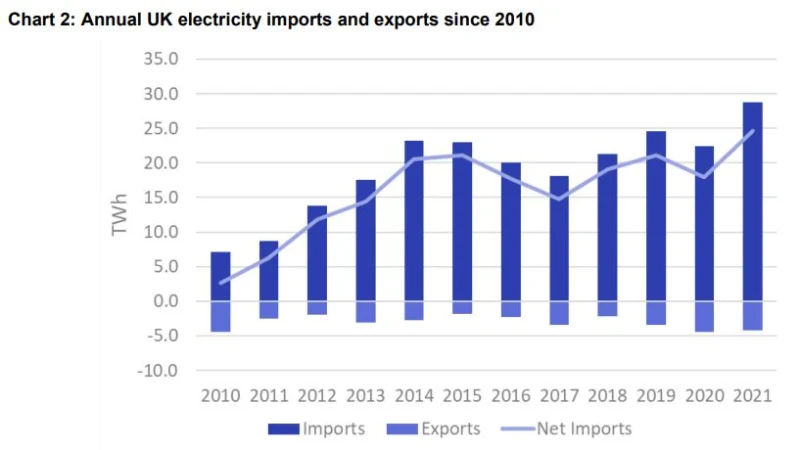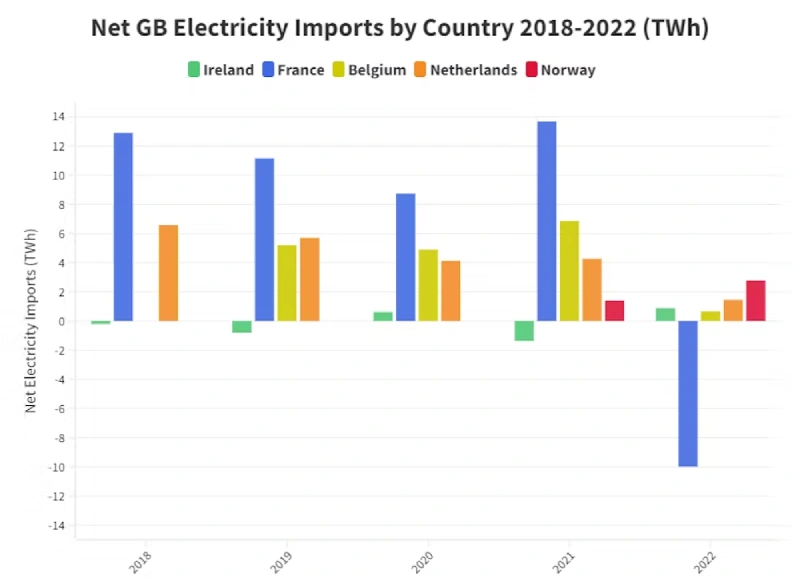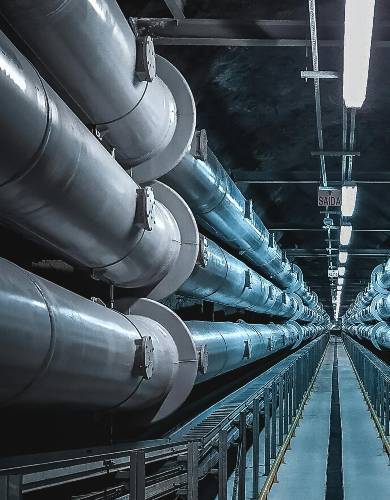Interconnectors: Giving the UK and EU a power boost
The UK has gone from a largely disconnected island that relied on its own power generation to have connections to multiple nations in Europe in just over a decade.
UK traders, suppliers and power stations are now partaking in a complex network of international contracts that are helping balance supply and demand, boost renewables, reduce energy costs, and improve energy security.
It is such a key component in UK energy we are surprised by the lack of attention it receives, so we took it upon ourselves to cover this growing sector.
Contents
- Interconnectors are the key infrastructure
- Who are the key stakeholders?
- The electricity markets
- The UK as a net importer of electricity (until 2022)
- The UK is now a net exporter of electricity!
- The importance of the electricity ForEx
- Conclusion
- External Resources
Interconnectors are the key infrastructure

Interconnectors are the key bits of infrastructure that facilitate electricity transfer across nations.
These high-voltage electricity cables run underwater or underground and allow the UK to import and export electricity to its neighbouring countries.
As of 2023, the UK has eight interconnectors with France, Belgium, the Netherlands, Ireland and Norway, with a total capacity of 8.4 GW, which is roughly double the peak capacity of the UK’s largest power station Drax.
| Name | Developers | Connection to | Capacity (GW) | Commission date |
|---|---|---|---|---|
| IFA | National Grid, RTE | France | 2.00 | 1986 |
| Moyle | Mutural Energy | Ireland | 0.50 | 2002 |
| BritNed | National Grid, TenneT | Netherlands | 1.00 | 2011 |
| East-West | EirGrid | Ireland | 0.50 | 2012 |
| Nemo Link | National Grid, Elia | Belgium | 1.00 | 2019 |
| IFA-2 | National Grid, RTE | France | 1.00 | 2021 |
| North Sea Link | National Grid, Stattnet | Norway | 1.40 | 2021 |
| ElecLink | Gerlink | France | 1.00 | 2022 |
Additionally, another seven interconnectors that will connect the UK with Denmark, Germany and Morocco (yes, the North African country’s excess solar energy output may come in useful) are proposed or under construction.
| Name | Developers | Connection to | Capacity (GW) | Commission date |
|---|---|---|---|---|
| Viking Link | National Grid, Energinet | Denmark | 1.40 | 2023 |
| Greenlink | Element Power, Partners Group | Ireland | 0.50 | 2023 |
| Gridlink | iCON Infra Partners | France | 1.40 | 2024 |
| NeuConnect | Meridian, Allianz, Kansai | Germany | 1.40 | 2024 |
| NorthConnect | Agder, Lyse, E-CO, Vattenfall | Norway | 1.40 | 2025 |
| FAB Link | Transmission Inv., RTE | France | 1.40 | 2025 |
| Xlinks | Intertek, Octopus | Morocco | 3.60 | 2027 |
Once operational, the UK will have a capacity of 19.5 GW, which is equivalent to 5 Draxes and will be crucial to ensuring energy security, lowering prices and giving renewable energy new markets to tap into.
Who are the key stakeholders?
At the base layer, a subsidiary of the National Grid Company oversees the operation of these interconnectors. They work together with infrastructure owners (yes, the builders, owners and operators may be different) to ensure that the infrastructure is safe, efficient and compliant with Ofgem regulations.
The national grid also oversees the performance and monitors the inflow and outflow of electricity (like a national commercial smart meter) to facilitate the electricity markets where both UK and international electricity traders, suppliers, generators and other businesses can participate.
The UK electricity market is liberalised, which means that there is a lot of freedom for all these participants to buy and sell electricity, with everyone being able to use the electrical grid infrastructure and interconnectors.
And who acts as a referee for these markets? None other than the national grid.
The national grid ensures that the net traded balance is compatible with the national supply and demand of electricity, which is priority number one.
The electricity markets
Within the UK wholesale electricity market, there are numerous niche markets where participants are buying and selling electricity as a commodity. Imagine the typical trading floor in movies but online.
In the UK, there are five markets, the Day-Ahead Market (DAM), Intraday Market (IDM) and the Balancing Mechanism (BM), which are operated by the National Grid ESO, and two futures and options markets, the N2EX and APX UK operated by NASDAQ and EPEX SPOT.
Most of the magic happens within these UK markets, but an increasingly large chunk finds its way into European and even international electricity exchanges. Traders can easily purchase UK electricity in one of the many European exchanges or even as far as the Singapore Exchange.
We digress as the volume traded within these electricity markets increases, the more efficient it becomes at identifying a fair price for UK electricity. This is key because the wholesale market is currently a dying dinosaur, where the wholesale prices bought by suppliers are defined by the most expensive (i.e. gas).
In order to change this, a really good price indicator becomes useful, and a growing market makes this increasingly precise. And everything has to happen without affecting the ability of countries to meet their electricity demands.
To ensure this, the UK is a member of several regional and international energy organizations, such as the European Network of Transmission System Operators for Electricity (ENTSO-E) and the International Energy Agency (IEA), which facilitate cooperation and coordination between national grid operators, energy policymakers and market participants.
The UK as a net importer of electricity (until 2022)

Over the past decade (at least until very recently), the UK has shifted to becoming a net electricity importer, with inflows accounting for over 9% of total electricity demand in 2021.
The increase in imports has been driven by several factors, principally the UK’s pledge to net-zero by 2050.
- The closure of coal-fired power plants over this period has led to a shortfall in baseload electricity, much of which was met by electricity imports from Europe.
- The growth of intermittent renewable energy to replace coal and oil always needed electricity imports as renewables cannot always produce at peak times.
- Six of the last nine interconnectors in operation in 2023 were built since 2011, facilitating the net import of electricity. Without them, importing electricity would have been impossible, and the UK would have had to decelerate the closure of coal power.
- Delays in the approval of nuclear power stations like Hinkley Point C that should have been producing energy during this period also forced the UK to rely on imports.
However, the latest energy crisis has turned electricity trading on its head, literally.
The UK is now a net exporter of electricity!

France took a dent in its reputation as the European colossus of low carbon electricity last year as it failed to produce its typical gargantuan nuclear power output.
News surfaced that EDF was not undertaking the appropriate maintenance of its nuclear fleet, resulting in 15 out of 56 nuclear reactors being temporarily closed for repairs, just at the same time as the 2022 global hike in energy prices.
Meanwhile, in the UK, Hornsea 2, the largest offshore wind farm in the world, was connected to the grid and was producing a ton of electricity during a gusty 2022, meaning there was spare electricity going around (ironically, this cheap electricity couldn’t be used to lower UK prices due to the existing dinosaur setup of the market).
The result was a sudden inversion in the electricity trade balance, with the UK turning from buyer to seller by a margin of 24 TWh in a matter of months. To put into context, this is equivalent to the amount of electricity consumed in Scotland in a year.
It is unclear if this is a permanent inflexion point or a temporary inversion, yet experts agree that Britain is expected to become a net exporter of electricity as it keeps expanding its portfolio of renewables.
The importance of the electricity ForEx
The rise of interconnectors and cheap renewables in the UK is opening the floodgates of electricity Forex, which is speculated to be ultimately very positive to the UK.
Energy security
The latest energy crisis has taught us the value of having surplus energy. Many Brits sunk into energy poverty this year due to a lack of preparation from the UK government and antiquated wholesale electricity pricing.
Having the possibility of importing electricity will make the UK much more resilient to these price variations (once the pricing can be fairly decided by the market).
But more importantly, it is there for emergencies. If the national grid or a power station gets hacked, or if an anomalously windless period leaves the UK lacking, or if a nuclear disaster happens, the UK can rely on its interconnectors for emergencies.
Without power, an entire nation can be brought to a standstill in this digital era.
A more competitive market
The rise in interconnectors is also bringing in an influx of foreign electricity buyers and sellers who have different appetites and prices.
This will make the market more competitive and efficient and is likely to lead to a reduction in prices over time.
Also, improving the efficiency of the markets will give future governments fewer excuses when it comes to new electricity pricing mechanisms.
Growth of renewables
Intermittent renewables can’t always take advantage of peak UK electricity prices as their output depends on weather conditions.
But when other markets are incorporated, there is suddenly a whole new set of needs to be met, as other countries have different peak times and policies that intermittent renewables can fill.
This is especially true considering these green electricity technologies cannot be charged any carbon taxes.
Conclusion
The growing electrical connectivity between the UK and mainland Europe has a subtle yet profound effect on Britain.
It is revolutionising how we think about national grids and creating new interdependencies that will hopefully be used to make electricity cheaper and more reliable.
So far, it has allowed the UK to reduce its reliance on fossil fuels while boosting energy security and reliability. Grid operators love the fact they can purchase electricity from foreign producers to meet any potential shortfalls in supply.
In the end, no one knows how it will all play out, but so far, it’s all winds behind the sails of an interconnected electrical world.

